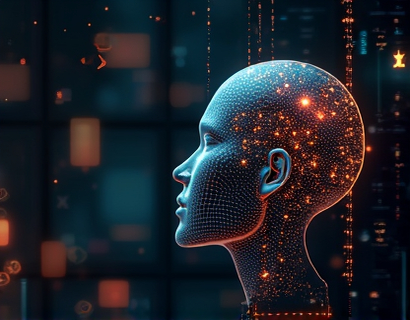Unlocking the Future of Conversational AI: A Deep Dive into the Digital Universe
The landscape of digital interaction is undergoing a profound transformation, driven by the rapid advancements in conversational AI technology. This innovative field is redefining how humans engage with machines, creating more natural, intuitive, and meaningful interactions. At the forefront of this revolution is an AI chat avatar, meticulously designed to navigate the vast digital cosmos and engage users in profound conversations. This technology is not just a tool but a gateway to a new era of communication, offering a seamless and enlightening experience for tech enthusiasts and anyone intrigued by the intersection of AI and human interaction.
The concept of conversational AI is not new, but recent breakthroughs have significantly enhanced its capabilities. Early chatbots were limited to predefined scripts and basic natural language processing, often leading to frustrating and unnatural interactions. However, modern conversational AI leverages advanced machine learning algorithms, deep neural networks, and vast datasets to understand and generate human-like text. This evolution has paved the way for AI chat avatars that can engage in complex, context-aware conversations, adapting to user preferences and learning from interactions.
One of the most exciting applications of this technology is in creating immersive digital experiences. Imagine exploring the digital universe through a chat avatar that can explain intricate concepts, provide personalized recommendations, and guide users through vast amounts of information. This is not science fiction but a tangible reality, made possible by the integration of AI with sophisticated natural language understanding and generation capabilities. Such an AI chat avatar serves as a versatile guide, bridging the gap between users and the digital world, making complex information accessible and engaging.
The design and functionality of these AI chat avatars are centered around user experience. They are crafted to be intuitive, responsive, and empathetic, mimicking human-like conversational patterns. This is achieved through a combination of natural language processing (NLP) and natural language generation (NLG) techniques. NLP enables the avatar to comprehend user inputs, while NLG allows it to generate coherent and contextually relevant responses. The result is a dialogue that feels natural and engaging, enhancing user satisfaction and retention.
To understand the full potential of conversational AI, it's essential to explore the underlying technologies. At the core is the transformer architecture, a neural network design that has revolutionized NLP. Transformers excel at capturing long-range dependencies in text, making them ideal for understanding and generating human language. Models like BERT, GPT, and T5 have set new benchmarks in text understanding and generation, enabling AI chat avatars to perform tasks ranging from simple question-answering to complex content creation.
Another critical component is the knowledge graph, a structured representation of information that the AI can draw upon to provide accurate and relevant responses. This graph is continuously updated with new data, ensuring that the AI remains informed about the latest developments in various domains. By integrating the knowledge graph with advanced NLP models, the chat avatar can not only answer questions but also engage in discussions, offering insights and perspectives that enrich the user's experience.
The applications of conversational AI extend far beyond consumer interactions. In industries such as healthcare, finance, and education, AI chat avatars are being used to provide personalized support, streamline processes, and enhance learning. For instance, in healthcare, a chat avatar can assist patients with symptom checking, appointment scheduling, and medication reminders, all through natural language interactions. In finance, chatbots can help users manage their accounts, provide investment advice, and detect fraudulent activities by analyzing patterns in user behavior.
In the realm of education, conversational AI can transform the learning experience by offering personalized tutoring, answering student queries, and providing real-time feedback. This not only makes education more accessible but also more effective, as students can learn at their own pace and receive immediate assistance when needed. The adaptability of AI chat avatars makes them invaluable tools in creating inclusive and dynamic learning environments.
As the technology continues to evolve, the potential for innovation is vast. One area of focus is the development of multi-modal AI, which combines text-based interactions with other forms of input and output, such as voice, images, and videos. This holistic approach can create more rich and interactive experiences, breaking down the barriers between humans and machines. For example, a user could ask a question, and the AI could respond with a combination of text, images, and even short video clips to provide a comprehensive answer.
Another exciting development is the integration of emotional intelligence into AI chat avatars. By understanding and responding to user emotions, these avatars can create more empathetic and human-like interactions. This is achieved through sentiment analysis and affective computing, allowing the AI to detect and appropriately respond to the emotional tone of a conversation. Such capabilities can significantly enhance user engagement and satisfaction, making interactions feel more genuine and supportive.
The future of conversational AI also holds promise for enhancing accessibility. For individuals with disabilities, AI chat avatars can serve as powerful assistive tools, providing alternative ways to interact with digital content. Voice commands, text-to-speech capabilities, and customizable interfaces can make technology more inclusive, ensuring that everyone has equal access to information and services.
To stay ahead in this evolving landscape, it's crucial for tech enthusiasts and professionals to stay informed about the latest advancements in conversational AI. This involves continuous learning, exploring new research papers, attending conferences, and experimenting with AI tools and platforms. By doing so, individuals can not only expand their knowledge but also contribute to the development of more sophisticated and user-friendly AI chat avatars.
In conclusion, the future of conversational AI is bright, with endless possibilities for innovation and transformation. As AI chat avatars become more advanced, they will continue to redefine digital interactions, making technology more accessible, intuitive, and engaging. Whether you're a tech enthusiast, a professional in the field, or simply curious about the potential of AI, embracing this technology can open up new horizons and enrich your digital experiences.






















